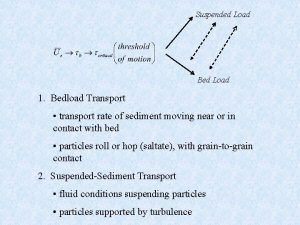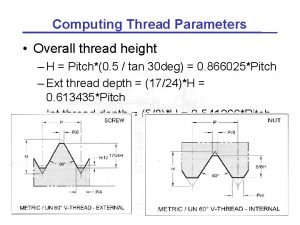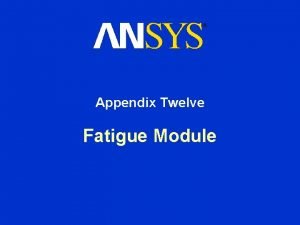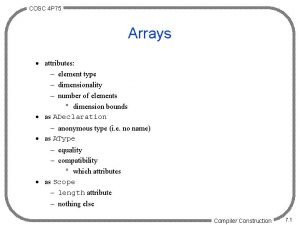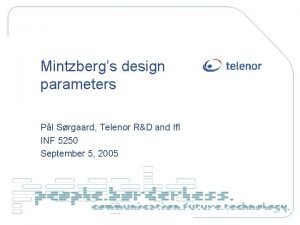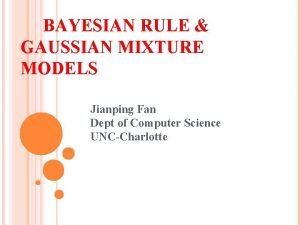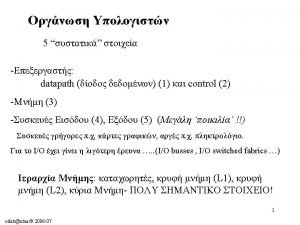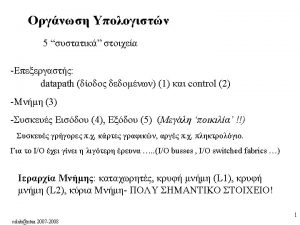insmod module ko module parameters Load the module






![③ 模块相关命令 • insmod <module. ko> [module parameters] – Load the module – 注意,只有超级用户才能使用这个命令 ③ 模块相关命令 • insmod <module. ko> [module parameters] – Load the module – 注意,只有超级用户才能使用这个命令](https://slidetodoc.com/presentation_image_h2/a948ae69f6d504220f85a747d70ff516/image-7.jpg)






















![8. 4 Linux字符设备驱动开发 • 应用程序如何使用字符设备, 一个例子 static char buf[1024]; int main(void) { int fd, 8. 4 Linux字符设备驱动开发 • 应用程序如何使用字符设备, 一个例子 static char buf[1024]; int main(void) { int fd,](https://slidetodoc.com/presentation_image_h2/a948ae69f6d504220f85a747d70ff516/image-30.jpg)













































- Slides: 75






![③ 模块相关命令 insmod module ko module parameters Load the module 注意只有超级用户才能使用这个命令 ③ 模块相关命令 • insmod <module. ko> [module parameters] – Load the module – 注意,只有超级用户才能使用这个命令](https://slidetodoc.com/presentation_image_h2/a948ae69f6d504220f85a747d70ff516/image-7.jpg)
③ 模块相关命令 • insmod <module. ko> [module parameters] – Load the module – 注意,只有超级用户才能使用这个命令 • rmmod – Unload the module • lsmod – List all modules loaded into the kernel –这个命令和cat /proc/modules等价 • modprobe [ r] <module name> – – Load the module specified and modules it depends


⑤ 最简单的内核模块例子(hello world) #include <linux/kernel. h> #include <linux/module. h> #include <linux/init. h> static int __init hello_init(void) { printk(KERN_INFO "Hello worldn"); return 0; } static void __exit hello_exit(void) { printk(KERN_INFO "Goodbye worldn"); } module_init(hello_init); module_exit(hello_exit);


⑥ 编译内核模块 • Makefile文件 obj m : = hello. o all: make C /lib/modules/$(shell uname r)/build M=$(shell pwd) modules clean: make C /lib/modules/$(shell uname r)/build M=$(shell pwd) clean • Module includes more files obj m: =hello. o hello objs : = a. o b. o

⑦ 装载和卸载模块 • 相关命令 –lsmod –insmod hello. ko –rmmod hello. ko


#include <linux/kernel. h> #include <linux/module. h> #include <linux/init. h> #include <linux/moduleparam. h> static int test; module_param(test, int, 0644); static int __init hello_init(void) { printk(KERN_INFO “Hello world test=%d n” , test); return 0; } static void __exit hello_exit(void) { printk(KERN_INFO "Goodbye worldn"); } MODULE_LICENSE("GPL"); MODULE_DESCRIPTION("Test"); MODULE_AUTHOR("xxx"); module_init(hello_init); module_exit(hello_exit);















cat /proc/devices
![8 4 Linux字符设备驱动开发 应用程序如何使用字符设备 一个例子 static char buf1024 int mainvoid int fd 8. 4 Linux字符设备驱动开发 • 应用程序如何使用字符设备, 一个例子 static char buf[1024]; int main(void) { int fd,](https://slidetodoc.com/presentation_image_h2/a948ae69f6d504220f85a747d70ff516/image-30.jpg)
8. 4 Linux字符设备驱动开发 • 应用程序如何使用字符设备, 一个例子 static char buf[1024]; int main(void) { int fd, size = 1024; fd = open(“/dev/fb 0”, O_RDWR); if(fd > 0) { read(fd, buf, size); … write(fd, buf, size); } return 0; }

• 字符设备通过文件系统中的名子来存取. 那些名子称为 文件系统的特殊 • 文件, 或者设备文件, 一般放在/dev目录下 #ls –l /dev/ crw rw rw 1 root 1, 5 Apr 11 2002 zero crw rw rw 1 root 1, 3 Apr 11 2002 null crw 1 root 4, 1 Oct 28 03: 04 tty 1 crw rw rw 1 root tty 4, 64 Apr 11 2002 ttys 0 crw rw 1 root uucp 4, 65 Apr 11 2002 tty. S 1 crw w 1 vcsa tty 7, 1 Apr 11 2002 vcs 1 crw w 1 vcsa tty 7, 129 Apr 11 2002 vcsa 1 其中, 类似 4, 1这样的数字叫设备的主, 次编号


分配和释放设备编号 • #include <linux/fs. h> int register_chrdev_region(dev_t first, unsigned int count, char *name); 您事先知道你需要哪个设备编号, 但不知道是否被使用, 调 用该函数 #include <linux/fs. h> int alloc_chrdev_region(dev_t *dev, unsigned int firstminor, unsigned int count, char *name); 您由系统动态分配设备编号, 用该函数 在设备注册后, 您的设备号将出现在/proc/devices中和/sys 中 释放以上两个函数分配的设备编号 void unregister_chrdev_region(dev_t first, unsigned int count); www. gdemb. com

字符设备注册 • 老方法: (Linux 2. 4及其之前版本) 注册 include <linux/fs. h> int register_chrdev(unsigned int major, const char *name, struct file_operations *fops); 注销 int unregister_chrdev(unsigned int major, const char *name); 一旦你的驱动注册成功, 系统就可以对你的设备进行 操作, 所以 在注册前, 你需要把你的fops结构准备好.

字符设备注册 • 新方法: (Linux 2. 6及其之后版本) 注册 include <linux/cdev. h> struct cdev *cdev_alloc(void); void cdev_init(struct cdev *dev, struct file_operations *fops); int cdev_add(struct cdev *dev, dev_t num, unsigned int count); 注销 void cdev_del(struct cdev *dev); cdev 结构管理的函数, 它代表内核中的字符设备 在注册前, 你需要把你的fops结构准备好









loff_tf_pos; //文件的当前位置 unsigned long f_reada, f_ramax, f_raend, f_ralen, f_rawin; /*预读标志、要预读的最多页面数、上次预读后的文件指针、预 读的字节数以及预读的页面数*/ struct fown_structf_owner; //文件的所有者 unsigned int f_uid, f_gid; //用户的UID和GID int f_error; unsigned long void struct kiobuf long }; f_version; *private_data; *f_iobuf; f_iobuf_lock; //网络写操作错误码 //版本号 //tty驱动程序使用



struct semaphore i_zombie; //索引结点的信号量 struct inode_operations *i_op; struct file_operations *i_fop; //指向文件操作的指针 struct super_block *i_sb; //索引结点操作 //指向读文件系统超级块指针 wait_queue_head_t i_wait; //指向索引结点等待队列的指针 struct file_lock *i_flock; //指向文件加锁链表的指针 struct address_space *i_mapping; //把所有可交换的页面管理起来 struct address_space i_data; struct dquot *i_dquot[MAXQUOTAS]; struct list_head i_devices; struct pipe_inode_info struct block_device struct char_device unsigned long //数据 *i_pipe; *i_bdev; *i_cdev; i_dnotify_mask; //索引结点的磁盘限额 //设备文件形成的链表 //指向管道文件 //指向块设备文件的指针 //指向字符设备文件的指针

struct dnotify_struct *i_dnotify; unsigned long i_state; //索引结点状态标志 unsigned int i_flags; unsigned char i_sock; atomic_t i_writecount; //写进程的引用计数 unsigned int i_attr_flags; //文件创建标志 u 32 i_generation; //保留 //文件系统的安装标志 //是否是套接字文件 union { struct minix_inode_info minix_i; …… struct jffs 2_inode_info void } u; }; *generic_ip; jffs 2_i;


与应用程序交换数据 • 交换的方式有很多, 最直接的方法是在struct file_operations 中的read/write方法中与用户空间的buffer进行数据的交换, 但它们不能进行类似于memcpy这样的拷贝, 而是使用内核提 供的接口来进行: #include <asm/uaccess. h> unsigned long copy_to_user(void __user *to, const void *from, unsigned long count); unsigned long copy_from_user( void *to, const void __user *from, unsigned long count);



虚拟字符设备驱动 实验从Hello world内核模块修改过来 1. 增加头文件和宏定义 #include <linux/fs. h> #include <asm/uaccess. h> 3. 增加open/release函数 static int test_chardev_open(struct inode *inode, struct file *file) { printk("test_chardev_open. . . n"); #define TEST_MAJOR 233 return 0; } 2. 增加静态变量 static char drv_name[] = “test”; static int test_chardev_release(struct static char tmpbuf[1024]; inode *inode, struct file *file) { static struct file_operations chardev_fops ={ printk("test_chardev_release. . . n". owner = THIS_MODULE, ); . read = test_chardev_read, return 0; }. write = test_chardev_write, . open = test_chardev_open, . release = test_chardev_release, }; 注意要让函的声明在结构前可见

虚拟字符设备驱动 4. 增加read函数 static ssize_t test_chardev_read (struct file *file, char __user *buf, size_t count, loff_t *offset) { if(count < 1024) { if(copy_to_user(buf, tmpbuf, count)) { printk(“copy to user failn”); return –EFAULT; } } else { printk(“buffer can not > 1024n”); return –EINVAL; } return count; } 5. 增加write函数 static ssize_t test_chardev_write(struct file *file, const char __user *buf, size_t count, loff_t *offset) { if(count < 1024) { if(copy_from_user(tmpbuf, count)) { printk(“copy from user failn”); return –EFAULT; } } else { printk(“buffer can not > 1024n”); return –EINVAL; } return count; }


虚拟字符设备驱动 • 测试应用程序test. c #include <stdio. h> #include <sys/types. h> #include <fcntl. h> #include <string. h> static char sz[] = “this is a test stringn”; staitc char readback[1024]; int main(void) { int fd; fd = open(“/dev/my_dev”, O_RDWR); if(fd > 0) { printf(“I am writing my device…n”); write(fd, sz, strlen(sz) + 1); read(fd, readback, strlen(sz) + 1); printf(“the string I read back is : %sn”, readback); } return 0; } 编译: arm linux gcc –o test. c, 运行 , 观察结果



在开发系统的安装目录下的include/asm-arm/arch-s 3 c 2410/s 3 c 2410. h文件中定 义了有关对各寄存器操作的宏:. . . #define GPIO_CTL_BASE 0 x 56000000 /*IO口控制寄存器及地址*/ #define b. GPIO(p) __REG(GPIO_CTL_BASE + (p))//寄存器地址0 X 50000000+p. . . #define GPBCON b. GPIO(0 x 10) /*寄存器地址0 X 56000010*/ #define GPBDAT b. GPIO(0 x 14) /*寄存器地址0 X 56000014*/ #define GPBUP b. GPIO(0 x 18) /*寄存器地址0 X 56000018*/ . . . #define GPCON(x) __REG 2(0 x 56000000, (x) * 0 x 10)//功能�� 寄存器地址 #define GPDAT(x) __REG 2(0 x 56000004, (x) * 0 x 10)//数据寄存器地址 #define GPUP(x) 器地址*/ __REG 2(0 x 56000008, (x) 0 x 10)//上 * 拉 �阻 �置 寄 存 . . .

#define GPIO_OFS_SHIFT 0 #define GPIO_PORT_SHIFTT 8 #define GPIO_PULLUP_SHIFT 16 #define GPIO_MODE_SHIFT 24 #define GPIO_OFS_MASK 0 x 000000 ff #define GPIO_PORT_MASK 0 x 0000 ff 00 #define GPIO_PULLUP_MASK 0 x 00 ff 0000 #define GPIO_MODE_MASK 0 xff 000000 #define GPIO_MODE_IN (0 << GPIO_MODE_SHIFT) #define GPIO_MODE_OUT (1 << GPIO_MODE_SHIFT) #define GPIO_MODE_ALT 0 (2 << GPIO_MODE_SHIFT) #define GPIO_MODE_ALT 1 (3 << GPIO_MODE_SHIFT) #define GPIO_PULLUP_EN (0 << GPIO_PULLUP_SHIFT) #define GPIO_PULLUP_DIS (1 << GPIO_PULLUP_SHIFT) #define PORTA_OFS 0 #define PORTB_OFS 1 …

#define MAKE_GPIO_NUM(p, o) ((p << GPIO_PORT_SHIFTT) | (o << GPIO_OFS_SHIFT)) #define GRAB_MODE(x) #define GRAB_PULLUP(x) (((x) & GPIO_MODE_MASK) >> GPIO_MODE_SHIFT) (((x) & GPIO_PULLUP_MASK) >> GPIO_PULLUP_SHIFT) #define GRAB_PORT(x) (((x) & GPIO_PORT_MASK) >> GPIO_PORT_SHIFTT) #define GRAB_OFS(x) (((x) & GPIO_OFS_MASK) >> GPIO_OFS_SHIFT) /*端口参数� 置宏*/ #define set_gpio_ctrl(x) ({ GPCON(GRAB_PORT((x))) &= ~(0 x 3 << (GRAB_OFS((x))*2)); GPCON(GRAB_PORT(x)) |= (GRAB_MODE(x) << (GRAB_OFS((x))*2)); GPUP(GRAB_PORT((x))) &= ~(1 << GRAB_OFS((x))); GPUP(GRAB_PORT((x))) |= (GRAB_PULLUP((x)) << GRAB_OFS((x))); })

#define set_gpio_pullup(x) ({ GPUP(GRAB_PORT((x))) &= ~(1 << GRAB_OFS((x))); GPUP(GRAB_PORT((x))) |= (GRAB_PULLUP((x)) << GRAB_OFS((x))); }) #define set_gpio_pullup_user(x, v) ({ GPUP(GRAB_PORT((x))) &= ~(1 << GRAB_OFS((x))); GPUP(GRAB_PORT((x))) |= ((v) << GRAB_OFS((x))); }) #define set_gpio_mode(x) ({ GPCON(GRAB_PORT((x))) &= ~(0 x 3 << (GRAB_OFS((x))*2)); GPCON(GRAB_PORT((x))) |= (GRAB_MODE((x)) << (GRAB_OFS((x))*2)); }) #define set_gpio_mode_user(x, v) ({ GPCON(GRAB_PORT((x))) & = ~(0 x 3 << (GRAB_OFS((x))*2)); GPCON(GRAB_PORT((x))) |= ((v) << (GRAB_OFS((x))*2)); }) #define set_gpio. A_mode(x) ({ GPCON(GRAB_PORT((x))) &= ~(0 x 1 << GRAB_OFS((x))); GPCON(GRAB_PORT((x))) |= (GRAB_MODE((x)) << GRAB_OFS((x))); })

#define read_gpio_bit(x) ((GPDAT(GRAB_PORT((x))) & (1<<GRAB_OFS((x)))) >> GRAB_OFS((x))) #define read_gpio_reg(x) GPDAT(GRAB_PORT((x))) #define write_gpio_bit(x, v) ({ GPDAT(GRAB_PORT((x))) &= ~(0 x 1 << GRAB_OFS((x))); GPDAT(GRAB_PORT((x))) |= ((v) << GRAB_OFS((x))); }) #define write_gpio_reg(x, v) (GPDAT(GRAB_PORT((x))) = (v)) … #define GPIO_B 7 MAKE_GPIO_NUM(PORTB_OFS, 7) #define GPIO_B 8 MAKE_GPIO_NUM(PORTB_OFS, 8) #define GPIO_B 9 MAKE_GPIO_NUM(PORTB_OFS, 9) #define GPIO_B 10 … MAKE_GPIO_NUM(PORTB_OFS, 10)


4. 6. 2 LED驱动程序代码分析 1. 系�� 源和宏定� #define DEVICE_NAME #define LED_MAJOR 231 "leds" /*定� led �� 的名字*/ /*定� led �� 的主�� 号*/ static unsigned long led_table []={ GPIO_B 0, /*I/O 方式led ���� 的 硬件� 源*/ GPIO_B 1, GPIO_B 6, GPIO_B 5, GPIO_B 7, GPIO_B 8, GPIO_B 9, GPIO_B 10, };


if (ret < 0) { printk(DEVICE_NAME " can't register major numbern"); /*注册失� ,� 出 提示信息*/ return ret; } devfs_handle = devfs_register(NULL, DEVICE_NAME, DEVFS_FL_DEFAULT, LED_ MAJOR, 0, S_IFCHR | S_IRUSR | S_IWUSR, &matrix 4_leds_fops, NULL); /*使用宏� 行端口初始化,set_gpio_ctrl 和write_gpio_bit 均� 宏定� */ for (i = 0; i < 8; i++) { set_gpio_ctrl (led_table[i] | GPIO_PULLUP_EN | GPIO_MODE_OUT); write_gpio_bit(led_table[i], 1); /*使I/O端口�� 的LED熄� */ } printk(DEVICE_NAME " initializedn"); return 0; }


5.ioctl入口,执行读、写之外的操作,通过参数cmd设定命令参数。 static int leds_ioctl(struct inode *inode, struct file *file, unsigned int cmd, unsigned long arg) { switch(cmd) { case 0: case 1: if (arg > 8) { return -EINVAL; } write_gpio_bit(led_table[arg], !cmd); default: return -EINVAL; } }

6.文件系统接口定义 static struct file_operations leds_fops = { owner: THIS_MODULE, ioctl: leds_ioctl, }; 7. 模块化 module_init(leds_init); module_exit(leds_exit); 用insmod命令加载模块时,调用module_init();用rmmod命令来卸载模块 时,会调用module_exit()函数。

8. 6. 3 LED驱动程序加载及测试 1.LED驱动程序加载 首先编写Makefile文件,如下所示: INCLUDE = /usr/linux/include EXTRA_CFLAGS = -D_ KERNEL_ -DMODULE –I $ (INCLUDE ) – 02 –Wall –O all: leds. o ledtest leds. o: leds. c arm-linux-gcc $(CFLAGS )$( EXTRA_CFLAGS) –c leds. c –o leds. o ledtest: ledtest. c arm-linux-gcc –g led. c –o ledtest clean: rm –rf leds. o rm –rf ledtest 对Makefile文件执行make命令后,可以生成驱动模块leds和测试程序ledtest了。


LED驱动程序测试: #include <stdio. h> #include <stdlib. h> #include <unistd. h> #include <sys/ioctl. h> int main(int argc, char **argv) {int on; int led_no; int fd; if (argc != 3 || sscanf(argv[1], "%d", &led_no) != 1 || sscanf(argv[2], "%d", &on) != 1 || on < 0 || on > 1 || led_no < 0 || led_no > 3) { fprintf(stderr, "Usage: ledtest led_no 0|1n"); exit(1);

fd=open(“/dev/leds”, 0); if (fd < 0) { perror("open device leds"); exit(1); } ioctl(fd, on, led_no); close(fd); return 0; } 应用程序编译正确后如输入: $ledtest 则提示:Usage: ledtest led_no 0|1 若输入:$ledtest 2 1 则点亮LED 3。

 The point of intersection of dc and ac load line is called
The point of intersection of dc and ac load line is called Axial load and radial load
Axial load and radial load Red dot
Red dot Pux
Pux Sự nuôi và dạy con của hổ
Sự nuôi và dạy con của hổ Thế nào là mạng điện lắp đặt kiểu nổi
Thế nào là mạng điện lắp đặt kiểu nổi Các châu lục và đại dương trên thế giới
Các châu lục và đại dương trên thế giới Các loại đột biến cấu trúc nhiễm sắc thể
Các loại đột biến cấu trúc nhiễm sắc thể Nguyên nhân của sự mỏi cơ sinh 8
Nguyên nhân của sự mỏi cơ sinh 8 Bổ thể
Bổ thể Phản ứng thế ankan
Phản ứng thế ankan Thiếu nhi thế giới liên hoan
Thiếu nhi thế giới liên hoan điện thế nghỉ
điện thế nghỉ Fecboak
Fecboak Bài hát chúa yêu trần thế alleluia
Bài hát chúa yêu trần thế alleluia Một số thể thơ truyền thống
Một số thể thơ truyền thống Trời xanh đây là của chúng ta thể thơ
Trời xanh đây là của chúng ta thể thơ Hệ hô hấp
Hệ hô hấp Công của trọng lực
Công của trọng lực Số nguyên tố là số gì
Số nguyên tố là số gì đặc điểm cơ thể của người tối cổ
đặc điểm cơ thể của người tối cổ Tỉ lệ cơ thể trẻ em
Tỉ lệ cơ thể trẻ em Các châu lục và đại dương trên thế giới
Các châu lục và đại dương trên thế giới ưu thế lai là gì
ưu thế lai là gì Môn thể thao bắt đầu bằng chữ đua
Môn thể thao bắt đầu bằng chữ đua Tư thế ngồi viết
Tư thế ngồi viết Hát kết hợp bộ gõ cơ thể
Hát kết hợp bộ gõ cơ thể Bàn tay mà dây bẩn
Bàn tay mà dây bẩn Cách giải mật thư tọa độ
Cách giải mật thư tọa độ Từ ngữ thể hiện lòng nhân hậu
Từ ngữ thể hiện lòng nhân hậu Tư thế ngồi viết
Tư thế ngồi viết Thế nào là giọng cùng tên
Thế nào là giọng cùng tên Voi kéo gỗ như thế nào
Voi kéo gỗ như thế nào Thẻ vin
Thẻ vin Thể thơ truyền thống
Thể thơ truyền thống Hổ đẻ mỗi lứa mấy con
Hổ đẻ mỗi lứa mấy con Thế nào là hệ số cao nhất
Thế nào là hệ số cao nhất Diễn thế sinh thái là
Diễn thế sinh thái là Lp html
Lp html Vẽ hình chiếu vuông góc của vật thể sau
Vẽ hình chiếu vuông góc của vật thể sau Làm thế nào để 102-1=99
Làm thế nào để 102-1=99 Lời thề hippocrates
Lời thề hippocrates Vẽ hình chiếu đứng bằng cạnh của vật thể
Vẽ hình chiếu đứng bằng cạnh của vật thể Tư thế worm breton
Tư thế worm breton đại từ thay thế
đại từ thay thế Quá trình desamine hóa có thể tạo ra
Quá trình desamine hóa có thể tạo ra C device module module 1
C device module module 1 Lesson 3 parameters and return practice 7
Lesson 3 parameters and return practice 7 Pore pressure parameters
Pore pressure parameters Metabolic acidosis correction formula
Metabolic acidosis correction formula Aacap practice parameters
Aacap practice parameters Pppqqq ne demek
Pppqqq ne demek Fatigue tool ansys
Fatigue tool ansys Arguments vs parameters
Arguments vs parameters Cosc parameters
Cosc parameters Fundamental parameters of antenna
Fundamental parameters of antenna Uplink design in satellite communication
Uplink design in satellite communication Zed certification benefits
Zed certification benefits Mintzbergs 5 ps
Mintzbergs 5 ps Instrumentation ppt
Instrumentation ppt Parameters and return practice
Parameters and return practice For counting the number of positional parameters
For counting the number of positional parameters Pho nation menu
Pho nation menu Abg normal values
Abg normal values Design parameters
Design parameters Method of variation of parameters
Method of variation of parameters Single phase half wave rectifier
Single phase half wave rectifier Ruby named arguments
Ruby named arguments Commoncase
Commoncase Hansen solubility sphere
Hansen solubility sphere Master planning parameters ax 2012
Master planning parameters ax 2012 Parameters of binomial distribution
Parameters of binomial distribution Zener diode parameters
Zener diode parameters Sap crm transaction launcher
Sap crm transaction launcher Pore pressure parameters
Pore pressure parameters Gaussian function
Gaussian function



